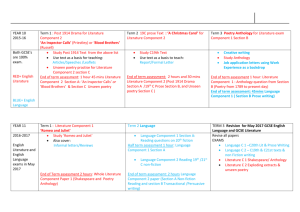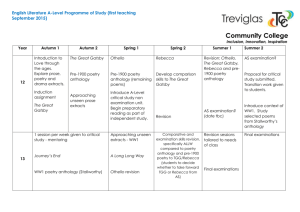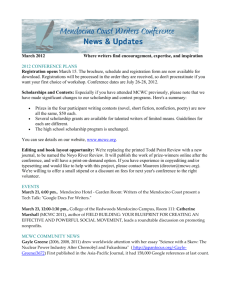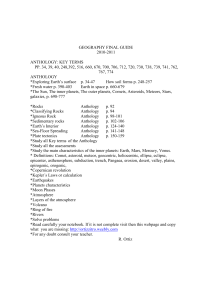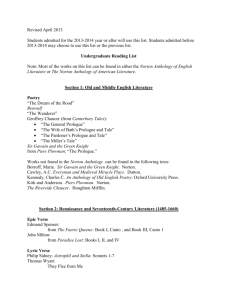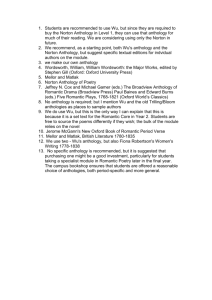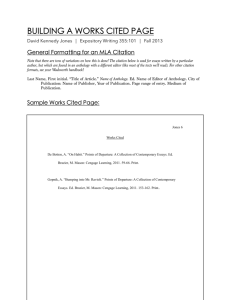ENGLISH DEPARTMENT READING LIST English
advertisement
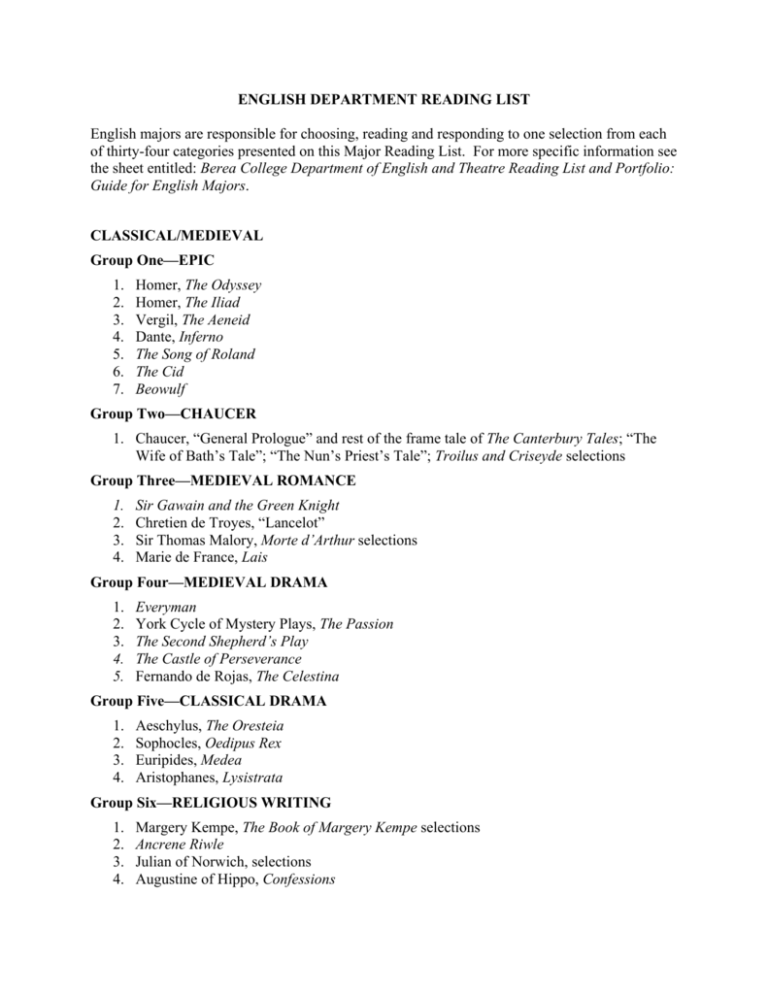
ENGLISH DEPARTMENT READING LIST English majors are responsible for choosing, reading and responding to one selection from each of thirty-four categories presented on this Major Reading List. For more specific information see the sheet entitled: Berea College Department of English and Theatre Reading List and Portfolio: Guide for English Majors. CLASSICAL/MEDIEVAL Group One—EPIC 1. 2. 3. 4. 5. 6. 7. Homer, The Odyssey Homer, The Iliad Vergil, The Aeneid Dante, Inferno The Song of Roland The Cid Beowulf Group Two—CHAUCER 1. Chaucer, “General Prologue” and rest of the frame tale of The Canterbury Tales; “The Wife of Bath’s Tale”; “The Nun’s Priest’s Tale”; Troilus and Criseyde selections Group Three—MEDIEVAL ROMANCE 1. 2. 3. 4. Sir Gawain and the Green Knight Chretien de Troyes, “Lancelot” Sir Thomas Malory, Morte d’Arthur selections Marie de France, Lais Group Four—MEDIEVAL DRAMA 1. 2. 3. 4. 5. Everyman York Cycle of Mystery Plays, The Passion The Second Shepherd’s Play The Castle of Perseverance Fernando de Rojas, The Celestina Group Five—CLASSICAL DRAMA 1. 2. 3. 4. Aeschylus, The Oresteia Sophocles, Oedipus Rex Euripides, Medea Aristophanes, Lysistrata Group Six—RELIGIOUS WRITING 1. 2. 3. 4. Margery Kempe, The Book of Margery Kempe selections Ancrene Riwle Julian of Norwich, selections Augustine of Hippo, Confessions English Department Reading List, continued page 2 5. “The Dream of the Rood,” “Caedmon’s Hymn” and selections from Bede’s Eccesiastical History 6. Genesis (King James’ version) RENAISSANCE/17TH Century Group Seven—SHAKESPEARE’S PLAYS (Choose two) 1. 2. 3. 4. 5. 6. 7. 8. 9. Othello A Midsummer Night’s Dream King Lear Henry V The Merchant of Venice A Winter’s Tale Hamlet Richard III Antony and Cleopatra Group Eight—16th/17th CENTURY POETRY 1. ANTHOLOGY: THE SONNET Sir Thomas Wyatt, “The Long Love That in My Thought Doth Harbor” and Farewell, Love” Henry Howard, Earl of Surrey, “Love, That Doth Reign and Live Within My Thought” and “The Soote Season” Sir Philip Sidney, Sonnets 1 and 31 from Astrophil and Stella and “Leave Me, O Love” Edmund Spenser, Sonnets 54 and 64 from Amoretti; William Shakespeare, Sonnets 3, 18, 29, 73, 97, 116, 130 2. ANTHOLOGY: JOHN DONNE “A Valediction Forbidding Mourning”; Meditation 17; “Song”; “Love’s Alchemy”; “The Flea”; “Air and Angels”; “Good Friday 1613. Riding Westward”; Holy Sonnets 5, 10, 14; “The Good Morrow”; “The Undertaking”; “The Funeral” 3. ANTHOLOGY: 17TH CENTURY POETS Robert Herrick, “Upon Julia’s Clothes,” “Upon the Nipples of Julia’s Breasts,” “Delight in Disorder” and “To the Virgins, to Make Much of Time” George Herbert, “The Collar,” “Man,” “Easter Wings,” “Sin’s Round” and “Love (3)” Richard Crashaw, “On the Wounds of Our Crucified Lord” Henry Vaughn, “The World” and “Silence and Stealth of Days” Andrew Marvell, “To His Coy Mistress” and “The Garden” Abraham Cowley, “To Mr. Hobbes” and “To the Royal Society” Thomas Traherne, “On Leaping Over the Moon” and “Wonder” Group Nine—SPENSER/MILTON/ALLEGORY 1. Edmund Spenser, “Epithalamion” and “Mutability cantos” 2. John Milton, “Lycidas,” “L’Allegro” and “Il Penseroso” and “When I consider how my light is spent” 3. ANTHOLOGY: Allegory English Department Reading List, continued page 3 John Bunyan, Pilgrim’s Progress Edmund Spenser, Book 1 of The Faerie Queene Group Ten—CONTINENTAL CONTEMPORARIES 1. Miguel de Cervantes, chapters from Don Quixote, excerpted in Norton Anthology of World Masterpieces 2. Jean-Baptiste Molière, Tartuffe 3. Jean Racine, Phaedra 4. Giovanni Boccaccio, from Decameron: Introduction of frame tale; First Day, Story 2 and Ninth Day, Story 2 5. Tirso de Molina, The Trickster of Seville 6. Pedro Calderon de la Barca, Life is a Dream 7. Lazarillo de Tormes 8. Lope de Vega, Fuenteovejuna 9. Michel de Montaigne, “Of Cannibals,” “Of the Inconsistency of Our Actions” and “Of Repentance” 10. Marguerite de Navarre, from The Heptameron: Story Three, Story Thirty and Story Forty 11. Sor Juana Ines de la Cruz, “Reply to Sor Filotea de la Cruz” Group Eleven—TUDORS and ELIZABETHANS 1. Ben Jonson, Volpone, “To the Memory of my Beloved Master William Shakespeare,” and “Ode to Himself” 2. Christopher Marlowe, “Hero and Leander” and Dr. Faustus 3. ANTHOLOGY: Prose Writers Francis Bacon, “Of Superstition” and “Of Studies” Sir Thomas Browne, Religio Medici selections Robert Burton, The Anatomy of Melancholy selections 4. Sir Thomas More, Utopia selections 18TH CENTURY Group Twelve—ALEXANDER POPE 1. The Dunciad; “An Essay on Criticism”; “The Rape of the Lock”; An Essay on Man” Group Thirteen—CONTINENTAL WRITERS 1. Voltaire, Candide 2. Jean-Jacques Rousseau, Confessions 3. Johann Wolfgang von Goethe, The Sorrows of Young Werther Group Fourteen—JONATHAN SWIFT 1. “A Modest Proposal”; Gulliver’s Travels; Poems—“A Description of the Morning,” “Stella’s Birthday, 1721” and “A Description of a City Shower” Group Fifteen—THE NOVEL 1. Samuel Richardson, Pamela 2. Henry Fielding, Tom Jones 3. Laurence Sterne, Tristram Shandy English Department Reading List, continued page 4 4. Anne Radcliffe, The Mysteries of Udolpho 5. Oliver Goldsmith, The Vicar of Wakefield Group Sixteen—18th CENTURY WRITERS 1. 2. 3. 4. Samuel Johnson, “The Vanity of Human Wishes” and Rasselas selections Oliver Goldsmith, She Stoops to Conquer John Dryden “Mac Flecknoe” and “The Knight’s Tale” ANTHOLOGY: 18TH CENTURY POETS Thomas Gray, “Elegy Written in a Country Churchyard” William Cowper, “The Castaway” James Thomas, “Evening and Night” from Autumn George Crabbe, Book 1 from The Village Philip Freneau, “The Wild Honeysuckle” Phyllis Wheatley, “To S. M., a Young African Painter, on Seeing his Works” and “On Being Brought from Africa to America” 5. James Boswell, Life of Johnson selections 6. Thomas Paine, Common Sense 19TH CENTURY Group Seventeen—ROMANTIC POETRY 1. ANTHOLOGY: BRITISH ROMANTIC POETS Robert Burns, “To a Mouse” and “To a Louse” William Wordsworth, “Tintern Abbey” and “The Ruined Cottage” Samuel T. Coleridge, “The Rime of the Ancient Mariner” and “Christabel” Percy B. Shelley, “The Triumph of Life” and “Ode to the West Wind” John Keats, “To Autumn,” “Ode to a Nightingale” and “The Eve of St. Agnes” George Gordon, Lord Byron, Canto I of Don Juan and “Darkness” William Blake, “The Marriage of Heaven and Hell” and “The Sick Rose” Group Eighteen—VICTORIAN POETRY 1. ANTHOLOGY: VICTORIAN POETS Alfred, Lord Tennyson, “Maud” and “Ulysses” Robert Browning, “The Bishop Orders his Tomb,” “Porphyria’s Lover” and “Fra Lippo Lippi” Matthew Arnold “Dover Beach” and “To Marguerite—Continued” Christina Rossetti, “Goblin Market” Elizabeth B. Browning, from Sonnets from the Portuguese: Sonnet 1 and Sonnet 43 and Aurora Leigh, Book I.195-240; Book II.1240-318 and Book V Lewis Carroll, “Jabberwocky” and Humpty Dumpty’s explication Gerard M. Hopkins, “Carrion Comfort” and “No Worst, There is None” from the Terrible Sonnets Group Nineteen—AMERICAN LITERATURE (Choose one anthology) 1. ANTHOLOGY 1: Walt Whitman, “Crossing Brooklyn Ferry” English Department Reading List, continued page 5 “Out of the Cradle Endlessly Rocking” “The Dalliance of Eagles” “Passage to India” “The Sleepers” Emily Dickinson, #130: “These are the days when the Birds come back—” #258: “There’s a certain Slant of light” #341: “After great pain, a formal feeling comes—” #465: “I heard a Fly buzz when I died—” #508: “I’m ceded—I’ve stopped being Theirs—” #712: “Because I could not stop for Death—” #742: “Four Trees —upon a solitary Acre—” #1400: “What mystery pervades a well!” 2. ANTHOLOGY 2: Ralph W. Emerson, “Self-Reliance” “Experience” “Nature” “The Poet” Henry D. Thoreau, from Walden, or Life in the Woods: “Where I lived, and What I Lived For” “The Ponds” “The Conclusion” Herman Melville, from Timoleon “After the Pleasure Party” “Monody” 3. ANTHOLOGY 3: Frederick Douglass, The Life and Times of Frederick Douglass, Chapters 7 and 10 Harriet Ann Jacobs, from Incidents in the Life of a Salve Girl, “The Jealous Mistress” “The Loophole of Retreat” Group Twenty—BRITISH FICTION 1. George Eliot, Silas Marner 2. Charles Dickens, Hard Times 3. William M. Thackeray, Vanity Fair 4. Mary Shelley, Frankenstein 5. Emily Bronte, Wuthering Heights 6. Charlotte Bronte, Jane Eyre 7. Jane Austen, Pride and Prejudice 8. Anthony Trollope, The Warden 9. George Meredith, The Egoist 10. Thomas Hardy, Tess of the D’Urbervilles Group Twenty-One—CONTINENTAL LITERATURE 1. Gustave Flaubert, Madame Bovary English Department Reading List, continued page 6 2. 3. 4. 5. Leo Tolstoy, The Death of Ivan Ilyich Fyodor Dostoevsky, Notes from the Underground Honoré de Balzac, Père Goriot FRENCH SYMBOLISM: ANTHOLOGY Charles Baudelaire, “To the Reader,” “Correspondence,” and “Spleen (IV)” Stéphane Mallarmé, “Autumn Complaint,” “The Old Saxony Clock” Arthur Rimbaud, “The Drunken Boat” and “The Lice-Hunters”/“The Lice-Finders” (two translations) Jules LaForgue, “Lightning of the Abyss” and “Winter Sunset” Paul Verlaine, “Claire de Lune” and “The Art of Poetry” 6. Benito Perez Galdos, Mercy 7. Emile Zola, L’Assomoir Group Twenty-Two—AMERICAN FICTION 1. 2. 3. 4. 5. 6. 7. 8. 9. Nathaniel Hawthorne, Blithedale Romance Herman Melville, “Bartleby the Scrivener” and Billy Budd Stephen Crane, The Red Badge of Courage Charlotte P. Gilman, “The Yellow Wallpaper”; Kate Chopin, The Awakening Harriet B. Stowe, Uncle Tom’s Cabin Mark Twain, Huckleberry Finn William Dean Howells, A Modern Instance Henry James, Portrait of a Lady Mary Wilkins Freeman, “A New England Nun”; Sarah Orne Jewett, “A White Heron”; Harriet Adams Wilson, from Our Nig, “Frado’s Childhood” 10. Willa Cather, My Antonía Group Twenty-Three—DRAMA 1. 2. 3. 4. 5. Henrik Ibsen, A Doll’s House Oscar Wilde, The Importance of Being Earnest Anton Chekhov, The Cherry Orchard George Buchner, Woyzeck August Strindberg, The Father 20TH CENTURY Group Twenty-Four—20TH CENTURY AMERICAN POETRY 1. ANTHOLOGY: 20th Century American Poets (Older, born before 1900) E. R. Robinson, “Luke Havergal”, “How Annandale Went Out” and “The Mill” Robert Frost, “After Apple Picking” and “Home Burial” Wallace Stevens, “Sunday Morning,” “Thirteen Ways of Looking at a Blackbird” and “The Idea of Order at Key West” Hart Crane, “At Melville’s Tomb” and “Chaplinesque” William C. Williams, “Spring and All,” “Landscape with the Fall of Icarus” and “The Widow’s Lament in Springtime” Marianne Morre, “The Fish” and “Poetry” Ezra Pound, “In a Station in the Metro,” “The River Merchant’s Wife: A Letter”; from The Cantos: “And then went down to the ship” English Department Reading List, continued page 7 Paul Laurence Dunbar, “Sympathy” and “We Wear the Mask” 2. ANTHOLOGY: 20th Century American Poets (Younger, born after 1900 and before World War II) Elizabeth Bishop, “The Fish,” “The Man-Moth” and “In the Waiting Room” Robert Lowell, “Skunk Hour” and “The Quaker Graveyard in Nantucket” Langston Hughes, “The Negro Speaks of Rivers” and “The Weary Blues” Stephen Spender, “The Funeral” and “Pylons” Theodore Roethke, “My Papa’s Waltz” and “Root Cellar” Delmore Schwartz, “Dogs are Shakespearean, Children are Strangers” and “The Mind Is an Ancient and Famous Capital” John Berryman, from The Dream Songs: #14 “Life, friends is boring” and #76: “Henry’s Confession” Gwendolyn Brooks, “We real cool” and “A Song in the Front Yard” William Stafford, “At the Bomb Testing Site” and “Traveling through the Dark” Ishmael Reed, “beware: do not read this poem” 3. T. S. Eliot “The Love Song of J. Alfred Prufrock”; Murder in the Cathedral Group Twenty-Five—AMERICAN FICTION 1. Two stories by William Faulkner, “Dat Evenin’ Sun” and “A Rose for Emily” 2. Three stories by Ernest Hemingway, “In Another Country,” “Hills Like White Elephants” and “A Clean, Well-Lighted Place” 3. Toni Morrison, The Bluest Eye 4. Ralph Ellison, Invisible Man 5. James Baldwin, Go Tell It on the Mountain 6. Two stories by Alice Walker, “To Hell with Dying” and “Everyday Use” 7. Two stories by Edith Wharton, “Roman Fever” and “Afterward” 8. Two stories by Eudora Welty, “Why I Live at the P. O.” and “Livvie” 9. Two stories by Zora N. Hurston, “Sweat” and “The Gilded Six-Bits” 10. Sherwood Anderson, Winesburg, Ohio 11. F. Scott Fitzgerald, The Great Gatsby 12. Two stories by Katharine Anne Porter, “The Downward Path to Wisdom” and “The Grave” 13. Carson McCullers, The Heart is a Lonely Hunter 14. Flannery O’Connor, “Revelation” and “A Good Man is Hard to Find” Group Twenty-Six—BRITISH FICTION 1. 2. 3. 4. 5. Two stories by James Joyce, “Araby” and “The Dead” Joseph Conrad, Heart of Darkness D. H. Lawrence, Women in Love Virginia Woolf, Mrs. Dalloway Two stories by Katherine Mansfield, “The Garden Party” and “Bliss” Group Twenty-Seven—CONTINENTAL LITERATURE 1. Franz Kafka, “Metamorphosis” 2. Albert Camus, The Plague 3. Thomas Mann, “Disorder and Early Sorrow” and “Mario and the Magician” English Department Reading List, continued page 8 4. 5. 6. 7. 8. 9. Rainer M. Rilke, Letters to a Young Poet Isaak Dinesen, “Babette’s Feast” and “The Blank Sheet” Louis-Ferdinand Celine, Voyage to the Edge of Night Gunther Grass, Local Anaesthetic Heinrich Boll, Billiards at Half Past Nine Miguel de Unamuno, Mist Group Twenty-Eight—20TH CENURY DRAMA 1. Luigi Pirandello, Six Characters in Search of an Author 2. George B. Shaw, Pygmalion 3. Eugene O’Neil, Long Day’s Journey Into Night 4. Tennessee Williams, Glass Menagerie 5. Samuel Beckett, Waiting for Godot 6. August Wilson, Fences 7. Federico Garcia Lorca, Blood Wedding 8. Jean Paul Sartre, No Exit 9. Bertolt Brecht, Mother Courage 10. Edward Albee, Who’s Afraid of Virginia Woolf? 11. Christopher Fry, The Lady’s Not for Burning 12. Lorraine Hansberry, A Raisin in the Sun 13. Athol Fugard, The Road to Mecca 14. Arthur Miller, Death of a Salesman 15. Caryl Churchill, Cloud Nine Group Twenty-Nine—INTERNATIONAL 1. 2. 3. 4. 5. 6. 7. 8. Chinua Achebe, Things Fall Apart Two stories by Nadine Gordimer, “The Catch” and “Happy Event” Machado de Assis, Dom Casmurro Jorge Luis Borges, “The Garden of Forking Paths,” “The Aleph” and “Borges and me” Yukio Mishima, “Patriotism” and “Swaddling Clothes” Gabriel Garcia Marquez, One Hundred Years of Solitude Juan Rulfo, “We are very poor” and “Talpa” ANTHOLOGY: Latin American Poets Cesar Vallejo, “Black Stone on a White Stone” and “The Wretched of the Earth” Pablo Neruda, “The Widower’s Tango” and “Entrance to the Woods” Gabriela Mistral, “The Liana” and “The Prayer” Octavio Paz, “Blanco” 9. Margaret Atwood, The Handmaid’s Tale 10. Anita Desai, “Games at Twilight” and Pigeons at Daybreak” Group Thirty—20th CENTURY BRITISH POETRY 1. ANTHOLOGY: 20TH Century British Poets Thomas Hardy, “Hap,” “He Never Expected Much” and “The Darkling Thrush” W. B. Yeats, “When You are Old,” “The Second Coming,” “Leda and the Swan,” “Sailing to Byzantium” and “Lake Isle of Innisfree” Dylan Thomas, “Do Not Go Gentle into that Good Night” and “Fern Hill” W. H. Auden, “Musée de Beaux Artes” and “Lullaby” English Department Reading List, continued page 9 A. E. Housman, “Loveliest of Trees,” “To an Athlete Dying Young” and “Terence, this is Stupid Stuff” Group Thirty-One—20th CENTURY CRITICISM (MODERN) 1. 2. 3. 4. M. H. Abrams, The Mirror and the Lamp Wayne C. Booth, The Rhetoric of Fiction Northrup Frye, Anatomy of Criticism Virginia Woolf, A Room of One’s Own and “Modern Fiction” (POSTMODERN) 5. Roland Barthes, Images, Music, Text 6. Barbara Christian, “The Race for Theory”; Florence Howe, “Feminism and Literature”; Paul Lauter, “Race and Gender in the Shaping of the American Literary Canon: A Case Study from the Twenties” 7. Jonathan Culler, The Pursuit of Signs: Semiotics, Literature, Deconstruction 8. Terry Eagleton, Literary Theory 9. Robert Scholes, Semiotics and Interpretation 10. Elaine Showalter, ed., The New Feminist Criticism: Essays on Women, Literature and Theory 11. David H. Richler, Falling into Theory: Conflicting Views on Reading Literature Group Thirty-Two—CRITICISM AND LITERARY THEORY 1. 2. 3. 4. 5. 6. 7. Sir Philip Sidney, “An Apology for Poetry” Samuel Johnson, “Preface to Shakespeare” John Dryden, “An Essay of Dramatic Posey,” excerpted in Norton Anth. William Wordsworth, “Preface to Lyrical Ballads” Percy B. Shelley, “A Defense of Poetry” Edgar A. Poe, “The Philosophy of Composition” T. S. Eliot, “The Use of Poetry and the Use of Criticism” and “The Three Voices of Poetry” 8. John Milton, Areopagitica selections 9. John Keats, selections from his letters Group Thirty-Three—COMMUNICATION AND MEDIA 1. 2. 3. 4. 5. Plato, Gorgias Aristotle, Rhetoric Kenneth Boulding, The Image Erving Goffman, The Presentation of Self in Everyday Life Neil Postman, Amusing Ourselves to Death Group Thirty-Four—FILM 1. 2. 3. 4. The General The Wind Singin’ in the Rain Citizen Kane English Department Reading List, continued page 10 5. The Seven Samurai 6. Persona 7. Two Daughters 8. Thelma and Louise 9. My Brilliant Career 10. Boyz N the Hood Group Thirty-Five—THEORIES OF WRITING 1. Anthology: Three essays by any three of the following writers: James Berlin, Carol Berkenkotter, Ann Berthoff, Wayne Booth, Robert Connors, Linda Flower and John R. Hayes, Richard Larson, Sondra Perl, Mike Rose, Nancy Sommers, Harvey Wiener, & W. Ross Winterowd 2. Anthology: Ann Ruggles Gere, “Teaching Writing: the Major Theories” plus two other essays on teaching writing by two of the following: Peter Elbow, Janet Emig, Toby Fulwiler, Andrea Lunsford, Donald Murray, & Mina Shaughnessy 3. Anthology: Gary Tate and Edward Corbett, The Writing Teacher’s Sourcebook: any three essays 4. David Crystal, Language and the Internet Group Thirty-Six—RHETORIC AND ARGUMENTATION 1. Sharon Crowley, Ancient Rhetoric for Modern Students 2. Stephen Toulmin, Uses of Argument Group Thirty-Seven—STYLE 1. Sheridan Baker, The Practical Stylist 2. Joseph Williams, Style: Ten Lessons in Clarity and Grace, “Understanding Style,” “Elegance,” & “The Ethics of Prose.” 3. Richard Lanham, Revising Prose Group Thirty-Eight—THEORIES/PROCESS OF DRAMA 1. Aristotle, Poetics 2. Anthology: August Strindberg, “Preface to Miss Julie” Arthur Miller, “Tragedy and the Common Man” Bertolt Brecht, “Theater for Pleasure or Theatre for Instruction” Group Thirty-Nine—THEORIES/PROCESS OF FICTION 1. Jeanette Winterson, Art and Lies 2. Margaret Atwood, Negotiating with the Dead : a Writer on Writing 3. W. Dale Brown, Of Fiction and Faith: Twelve American Writers Talk about their Vision and Work. 4. May Sarton, Writings on Writing Group Forty—THEORIES/PROCESS OF POETRY 1. Rainer Marie Rilke, Letters to a Young Poet 2. Natalie Goldberg, Writing Down the Bones: Freeing the Writer Within 3. Adrienne Rich, Arts of the Possible: Essays and Conversations English Department Reading List, continued page 11 4. Bill Moyers, Fooling with Words : A Celebration of Poets and their Craft or The Language of Life [Interviews] 5. Robert Morgan, Good Measure : Essays, Interviews, and Notes on Poetry 6. Charles R. Duke & Sally A. Jacobsen, eds., Poets' Perspectives : Reading, Writing, and Teaching Poetry Group Forty-One—WRITERS ON WRITING 1. Arthur Miller, Timebends 2. Scott Russell Sanders, Writing from the Center 3. Eudora Welty, One Writer’s Beginnings 4. Galway Kinnell, Writing the Australian Crawl 5. Annie Dillard, The Writing Life 6. Bell Hooks, Remembered Rapture: the Writer at Work 7. Joyce Carol Oates, Compiler. First Person Singular: Writers on their Craft. 8. Julia Cameron, The Right to Write : an Invitation and Initiation into the Writing Life Group Forty-Two—SOCIAL PERSPECTIVES ON WRITING: GENDER, RACE, AND CLASS 1. 2. 3. 5. 6. Bell Hooks, Acquiring Language Carolyn Heilbrun, Writing a Woman’s Life Joanna Russ, How to Suppress Women’s Writing Tillie Olsen, Silences Rita Mae Brown, Starting from Scratch : A Different Kind of Writer's Manual Group Forty-Three—BIOGRAPHY/AUTOBIOGRAPHY 1. James Boswell, Life of Samuel Johnson 2. Janet Malcolm, Silent Woman: Sylvia Plath and Ted Hughes 3. Mike Rose, Lives on the Boundary 4. Gertrude Stein, Autobiography of Alice B. Toklas 5. Lillian Hellman, An Unfinished Woman, Pentimento, or Scoundrel Time 6. Malcolm X, Autobiography of Malcolm X 7. Sylvia Plath, Bell Jar 8. Maxine Hong Kingston, Woman Warrior 9. Arnold Rampersad, Life of Langston Hughes 10. Mary Brave Bird, Lakota Woman Group Forty-Four—SCIENCE & NATURE WRITING 1. 2. 3. 4. 5. 6. 7. Loren Eiseley, Night Country Annie Dillard, Pilgrim at Tinker Creek John McPhee, The Control of Nature Barry Lopez, Arctic Dreams or Rediscovery of North America Wendell Berry, Continuous Harmony, Gift of Good Land, or Home Economics Rick Bass, Platte River Rachel Carson, Edge of the Sea or Under the Sea Wind Group Forty-Five—TRAVEL WRITING 1. John McPhee, Coming into the Country English Department Reading List, continued page 12 2. 3. 4. 5. Beryl Markham, West with the Night Isabella Bird, A Lady’s Life in the Rocky Mountains Peter Mathissen, Snow Leopard Robert Pirsig, Zen and the Art of Motorcycle Maintenance Group Forty-Six—LETTERS John and Abigail Adams Emily Dickinson John Keats D. H. Lawrence John Ruskin, Letters from Venice Elinore Pruitt Stewart, Letters of a Woman Homesteader Mark Twain Group Forty-Seven—JOURNALS AND DIARIES Samuel Pepys Dorothy Wordsworth Henry David Thoreau Katherine Mansfield Virginia Woolf May Sarton, Journal of a Solitude Sheila Bender, 40 Contemporary Writers and their Journals Revised Fall 2003
